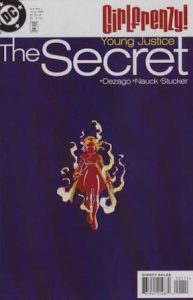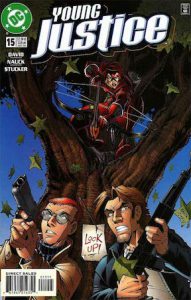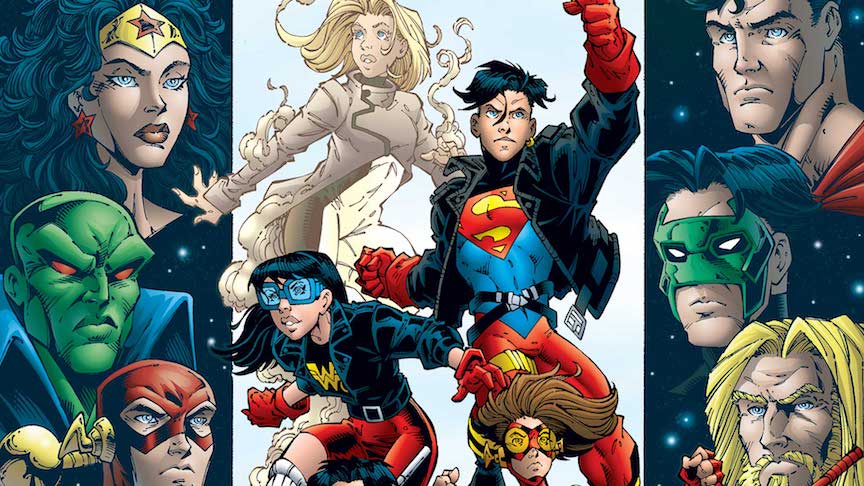With JUSTICE LEAGUE out in theaters now, I’m taking an all-too-brief look at the vast history of the team since its inception back in 1960. In this installment, we travel to the late-1990s, when a group of young heroes come together and decide to fight crime in their own way. They aren’t the Junior Justice League – they’re YOUNG JUSTICE!
In the Silver Age, the young sidekicks of Batman, Green Arrow, Wonder Woman, Aquaman and The Flash joined together to form the Teen Titans. While comic book characters don’t necessarily need to age, the young heroes who formed the team did manage to grow up over the years and dropped the “Teen” from the name. By the late-1990s, the former Teen Titans were no longer sidekicks, and were heroes in their own right. A new generation of young heroes had emerged, though, and it was time for them to take the spotlight.
 First coming together during a Fifth-Week event called “GIRL FRENZY” (which focused on the women of the DC Universe), the original line-up of Young Justice consisted of Robin (Tim Drake, the third teen to take on the mantle), Superboy (Kon-El, the young clone of Superman created after Superman died) and Impulse (Bart Allen, the grandson of Barry Allen, from the far-flung future). The three teens came together to save a young girl who was being held against her will by the Department of Extranormal Operations. The YOUNG JUSTICE: THE SECRET one-shot, written by Todd Dezago, gave way to a new ongoing series featuring the heroes, written by Peter David with art by Todd Nauck.
First coming together during a Fifth-Week event called “GIRL FRENZY” (which focused on the women of the DC Universe), the original line-up of Young Justice consisted of Robin (Tim Drake, the third teen to take on the mantle), Superboy (Kon-El, the young clone of Superman created after Superman died) and Impulse (Bart Allen, the grandson of Barry Allen, from the far-flung future). The three teens came together to save a young girl who was being held against her will by the Department of Extranormal Operations. The YOUNG JUSTICE: THE SECRET one-shot, written by Todd Dezago, gave way to a new ongoing series featuring the heroes, written by Peter David with art by Todd Nauck.
David’s first issue saw the boys having a camp-out, where we meet archeologist Nina Dowd, who gets imbued with the power of an ancient artifact and becomes the villainess Mighty Endowed. And yes, she is defeated partially because she’s a bit top-heavy now.
There’s nothing you can do about that joke. You see it coming and you can’t even get out of the way…
While the first few issues of Robin, Superboy and Impulse were fun, the series really didn’t kick into high gear until the girls were added to the team. With issue 4, Wonder Girl (Cassie Sandsmark), Arrowette (Cissie King-Jones) and Secret – the girl who was saved in the original one-shot, break up the boys club and form the core of the team that would run through most of the book’s run.
Young Justice was never officially an offshoot of the JLA, but the mentors of the team members all agreed that giving the younger heroes some experience working together would benefit them. The mentors assigned android-with-a-soul Red Tornado to watch over the teen heroes. Peter David’s Tornado was an amazing part of the group, mostly annoyed with the team’s recklessness (which shouldn’t be a surprise with a kid named IMPULSE on the team) and fascinated that the kids were able to make him manifest human emotions in his robot body.
 Much of what David did with Young Justice was played for laughs, and nothing was taken too seriously.Though when he needed to, David could produce an issue that let the funny lay by the wayside in exchange for a heart-wrenching tale. Secret’s origin, where she was murdered by her sociopathic brother, smacked readers hard when it first appeared. Secret’s brother, Billy, turned out to be one of YJ’s main villains, the anti-Robin known as Harm. Another came with issue 15, which focused on Arrowette, who was hunting the ex-fiancee of Arrowette’s school psychologist, who murdered the woman after she broke off the engagement. Arrowette was shooting to kill, and would have put an arrow in the murderer and his accomplice if not for the timely intervention of Superboy, who talked her down.
Much of what David did with Young Justice was played for laughs, and nothing was taken too seriously.Though when he needed to, David could produce an issue that let the funny lay by the wayside in exchange for a heart-wrenching tale. Secret’s origin, where she was murdered by her sociopathic brother, smacked readers hard when it first appeared. Secret’s brother, Billy, turned out to be one of YJ’s main villains, the anti-Robin known as Harm. Another came with issue 15, which focused on Arrowette, who was hunting the ex-fiancee of Arrowette’s school psychologist, who murdered the woman after she broke off the engagement. Arrowette was shooting to kill, and would have put an arrow in the murderer and his accomplice if not for the timely intervention of Superboy, who talked her down.
Arrowette’s near murder led into a major Fifth Week event featuring Young Justice, called Sins of Youth, where the DC Universe’s teen heroes were turned into adults and the adults were turned into kids in a fit of magic from Klarion the Witch Boy. With Young Justice in the midst of its second year, having a major event like Sins of Youth is a pretty big deal, especially since some of the ramifications from the story – like Superboy losing his powers – were reflected in other books.
The main characters featured in Young Justice were given so much character development and growth over the course of the series, sometimes even more so than in the heroes’ main books (only Impulse, Robin and Superboy were featured in solo titles, though). A lot of what comic book readers love about these characters post-1998 came from what Peter David did with them (especially Superboy, whose blossoming relationship with Wonder Girl survived past the series’ run). The book’s 55-issue run really defined the young heroes of the DC Universe in the late 1990s and early 2000s.
Once the book ended – with a confrontation with Darkseid, lord of Apokolips – the core members of the team mixed with members of the also cancelled Titans series to form a new Teen Titans book, written by Geoff Johns. The current chief creative officer of DC Comics had a heralded run with the Teen Titans, but much of what he did wouldn’t have been possible without the work of Peter David on Young Justice.
In May, DC Comics released YOUNG JUSTICE Vol. 1, which collects the main book’s first seven issues along with some of the specials that led into the series. That book is currently a part of a huge sale at Comixology, where it’s discounted to $4.99, along with about 1,600 other DC Comics collections. No, really, you should check it out.
